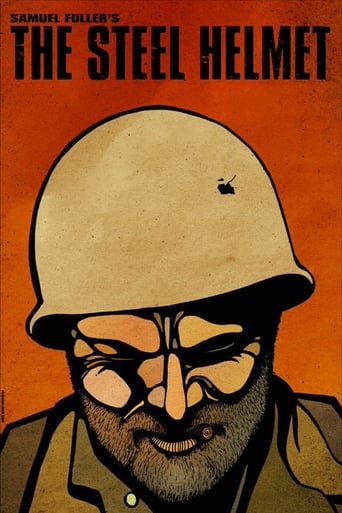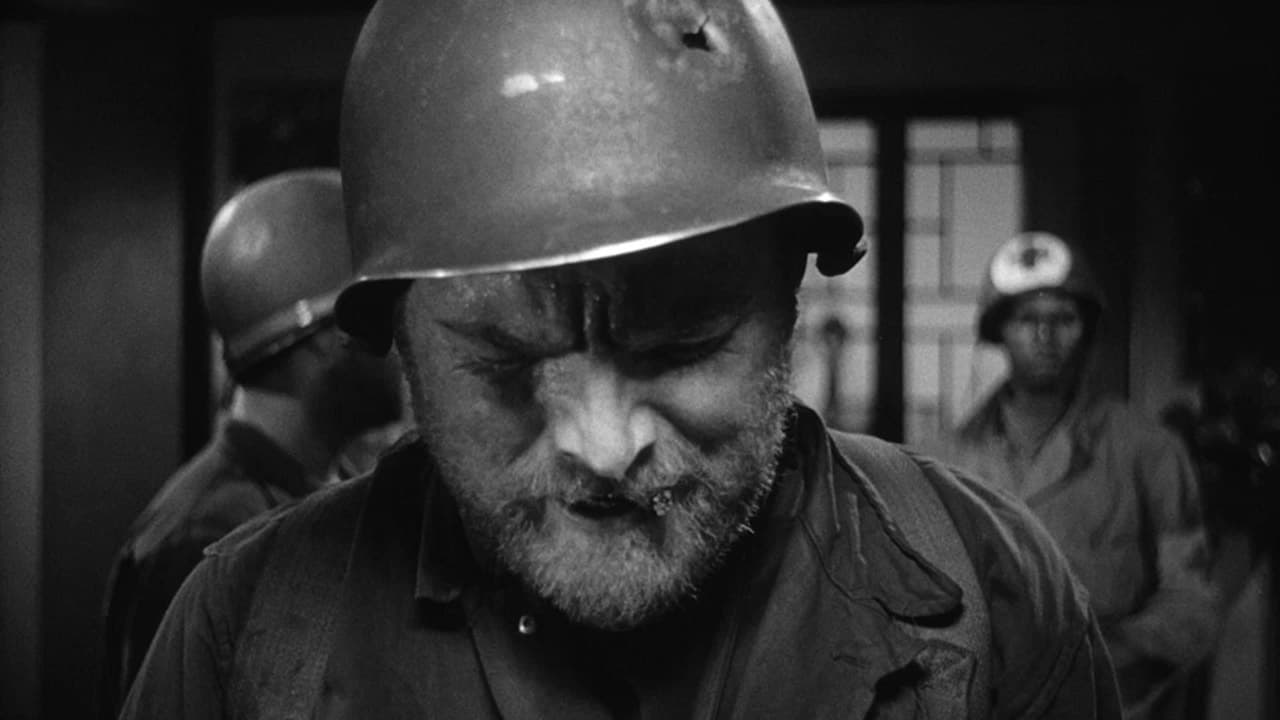Claudio Carvalho
In the Korean War, the prisoner of war Sergeant Zack (Gene Evans) and only survivor of his company is released by the South-Korean boy Short Round (William Chun). The walk together trying to reach the American lines, and they stumble with other survivors, forming a ragtag platoon.When they reach a Buddhist temple, they learn that it is abandoned and they camp there, transforming it in an observation outpost. When they realize that they are under siege of the communist army, they have to battle to survive. "The Steel Helmet" is a simple, scathing and extremely realistic film by Samuel Fuller. The behavior of the soldiers and the battle scenes battle scenes are extremely realistic. But the stronger part is the sharp critic to the racism in America, through the dialog of the North Korean POW and the Afro-American soldier first and the Asian descendant soldier later. As an effect of the McCarthyism, Samuel Fuller had problems with the FBI because of these scenes. My vote is eight.Title (Brazil): "Capacete de Aço" ("Steel Helmet")
Robert J. Maxwell
This was shot on a minuscule budget in ten days. It's not an insulting movie or a bad one, but the headlong and inexpensive rush shows.This was one of Sam Fuller's first big hits. It's about a squad of infantrymen manning an isolated observation post during the Korean war. Fuller had been a Chicago newspaperman and he wrote and directed this effort as if rattling off a story under a deadline. Bing bang boom. The point is made and the story rolls along. Sometimes it rolls along even if the point fails to be made. I used to read equally cogent stories of the Korean war in comic books when I was a kid.There are no bankable stars but most of the cast are believable. It's good to see Richard Loo, a Hawaiian-born Chinese, playing a Japanese again, only this time on our side. A North Korean prisoner gets to needle him about the relocation camps. James Edwards, an African-American, gets needled too, but he's as stalwart as ever.It's an ensemble film but primus inter pares is the bearded, funky, cigar-chewing, ugly Gene Evans as the tough top sergeant who dislikes officers, conscientious objectors, charming young Korean boys, and -- let me see, who else exists? Evans is an actor whose appeal has always eluded me, although his home town, Holbrook, Arizona, was always a comfortable little outpost in the middle of the desert, until recently when it was engulfed by sprawling malls. The cultural center of the tiny place used to be the Dairy Queen, located where the through road, which no one of discernment would call "a highway", makes a dogleg.Anyway -- where was I? -- anyway, Evans has one glorious moment on screen. In the midst of the final battle, with bullets whizzing and shells exploding, men being blown to bits, and everything wreathed in smoke, Fuller shows us Gene Evans hammering away at the enemy from behind a machine gun. Then -- with no warning whatever -- Fuller cuts to a close up of Evans' face as he stops firing. Evans' eyeballs widen and he seems for a moment transported. His face seems to glow by means of some inner mechanism. He stumbles to his feet and amid the carnage wanders around hallucinating -- "Did you hear the colonel?" What a scene! A huge and somehow ominous statue of the Buddha appears to play an important role in this movie but I don't know what it is. The one thing I'm sure of is that Fuller's experience as an combat infantryman in the First Division shaped the remainder of his life. He never forgot it or rather he never got over it, and he'd been no longer a kid. He was thirty-four. For years afterward he woke up at the slightest sound. But none of this stopped him from the kind of reckless enterprise that this movie represents.
Scarecrow-88
A grumpy infantry sergeant, a South Korean kid, and a black Medic officer meet each other within the war torn wilderness of Korea, soon lending a helping hand to a troop of green officers, who will engage in combat with a flurry of North Korean soldiers, their fort and refuge a Buddhist temple.Gene Evans plays the hard, snake-skin tough infantry soldier who seems to put his priorities over everyone else, but is the first in line when it comes to engage in combat with the enemy. He's an imperfect, flesh-and-blood man who lays it on the line when needed the most..an admirable, but flawed character which adds a realism often missing from films during this period in cinema. William Chun is the Buddhist child who Evans grows fond of(..although, he puts up a front as if he doesn't)often writing prayers for those he feels need them. James Edwards is the black medic(..who patches up Evans and others), a dependable, wise man, thankfully a role that transcends the use of African-American actors, and Richard Loo lands a great role as a Japanese American Sgt, who actually assists Evans in downing North Korean soldiers shooting from atop trees in an early sequence. The film voices aloud racism and how minorities have been singled out in unfortunate ways at home..by a North Korean POW, no less, they capture within the Buddhist temple. The combat sequence at the end, between the limited American troops in the temple against the North Korean battalion coming from the hills towards them, as bombs drop from afar, along with a tank blasting off and rounds of ammunition giving off smoke that's hard to see through, is astonishing.It's a testament to Sam Fuller's abilities as a director that he was able to make such a phenomenal little war film for such little money, in only a span of days. Fuller's script takes time establishing unique characterizations, anchored by Evans(..his experience in the field used to enhance his infantry man), and what I think makes STEEL HELMET such a success is how realistic and human they really are.
lastliberal
Ah, the Fifties. A time when America embraced racism like a badge of honor. Hoover and his FBI investigates writer/director Fuller for communist tendencies because he dared expose the fact that we use people as soldiers when they have to ride the back of the bus at home.It is a film that tries to present realism in war on a low budget. Even the North Korean tank was obviously made out of plywood. But that is not important.We see real soldiers, not pretty boys from the WB. They have real prejudices that they manage to overcome to some extent. It is a ragtag group that presents many faces and backgrounds all united in a common purpose - freedom. They even have a Korean boy tagging along, and they are surprised to learn when they are playing Auld Lang Syne on an organ that it is just like the Korean National Anthem as he starts singing.It all takes place in a Buddhist temple - a symbol of peace, that becomes a place of death.Gritty realism in this first Koren War film, and a message to all Americans that is still relevant today.


 AD
AD



